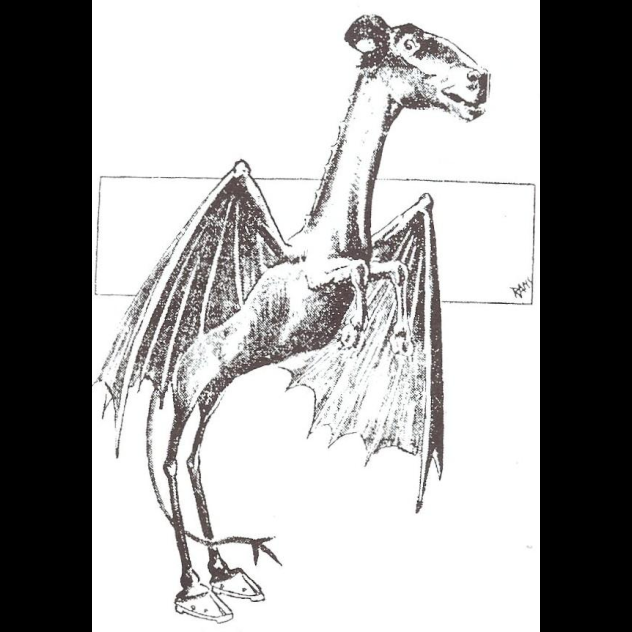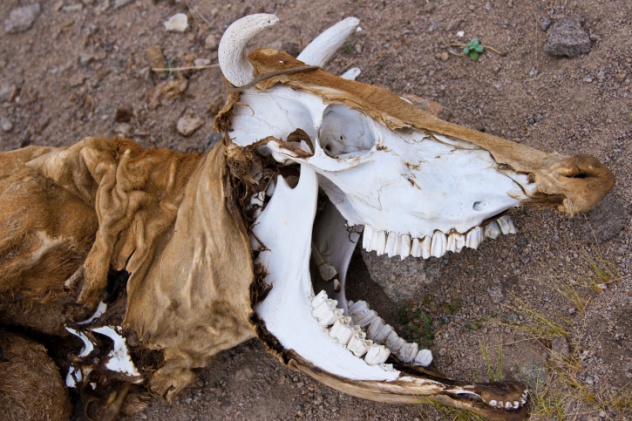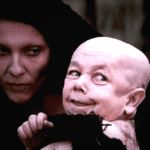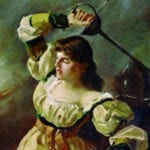 Misconceptions
Misconceptions  Misconceptions
Misconceptions  History
History 10 Amazing Roman Epitaphs
 Weird Stuff
Weird Stuff 10 Niche Subcultures That Are More Popular Than You Might Think
 Mysteries
Mysteries 10 Tragic Disappearances and Deaths in Joshua Tree National Park
 History
History 10 Ways Childhood Really Sucked in the Old West
 Music
Music 10 Name Origins of Famous Bands from the 1990s
 Religion
Religion 10 Biggest Turnarounds by the Catholic Church
 Weird Stuff
Weird Stuff 10 Unbelievable Times Laws Had Unintended Consequences
 Humans
Humans Ten Historic Women Who Deserve Way More Credit Than They Got
 Movies and TV
Movies and TV 10 Films That Spawned Major Lawsuits
 Misconceptions
Misconceptions 10 Phony Myths and Urban Legends That Just Won’t Die
 History
History 10 Amazing Roman Epitaphs
 Weird Stuff
Weird Stuff 10 Niche Subcultures That Are More Popular Than You Might Think
Who's Behind Listverse?

Jamie Frater
Head Editor
Jamie founded Listverse due to an insatiable desire to share fascinating, obscure, and bizarre facts. He has been a guest speaker on numerous national radio and television stations and is a five time published author.
More About Us Mysteries
Mysteries 10 Tragic Disappearances and Deaths in Joshua Tree National Park
 History
History 10 Ways Childhood Really Sucked in the Old West
 Music
Music 10 Name Origins of Famous Bands from the 1990s
 Religion
Religion 10 Biggest Turnarounds by the Catholic Church
 Weird Stuff
Weird Stuff 10 Unbelievable Times Laws Had Unintended Consequences
 Humans
Humans Ten Historic Women Who Deserve Way More Credit Than They Got
 Movies and TV
Movies and TV 10 Films That Spawned Major Lawsuits
10 Devilishly Tall Tales Of The Jersey Devil
Urban legends, folklore, mythology, and cryptozoology are all popular subjects here at Listverse. We love tales of mysterious places, unexplained mysteries, and unlikely critters, whether or not we believe in them. The tale of the Jersey Devil encompasses all of this and more.
A wealth of stories about the cryptid exist, and they warrant an in-depth look. To this very day, people still say that they’ve seen it roaming the New Jersey woods. In fact, the Jersey Devil (aka the Leed’s Devil) has been a part of its state’s history for so long that, in 1939, New Jersey became the only US state with an official state demon. Their hockey team is also named after the beast. Let’s learn a bit more about the Jersey Devil, and you can decide for yourself whether a creature truly stalks the state or if it’s all just a bunch of tall tales.
10 Birth Of The Jersey Devil
There are several variations to the story of the Jersey Devil’s birth. Most agree that its mother was a poor Quaker woman named Mother Leeds (or a young woman from Leed’s Point) who lived as a widow with her large family of 12 children in a cabin in Estellville. Mother Leeds was suspected of witchcraft, and when she gave birth to a 13th child, the event was attended by several curious onlookers.
Some say that Mother Leeds cursed her misfortune of bringing another child into her already impoverished family, crying out, “Let this child be a devil!” as she went into labor. Others claim that the child was born deformed, and still others talk of a gypsy curse. The most popular tales claim that the child was born normal at first, but before the eyes of the terrified onlookers (or only a local pastor), it changed. Its body stretched, and it sprouted wings and a tail. Its feet became cloven, and its head grew horse-like and horrible. Some stories claim that mother Leeds confined the beast until it escaped, while others assert that the beast would visit her nightly until driven away, but most say that the Jersey Devil rose up and attacked everyone in the room, including its mother, and then flew out into the night.
Today, the southern end of New Jersey consists of small towns such as Smithville, Absecon, and the infamous Leed’s Point. The points between are filled with wilderness. Houses can be few and far between, and even today there are few streetlights to light the way. It’s not hard to imagine how dark and claustrophobic it must have been in 1735, easily inspiring tales of monsters.
9 Joseph Bonaparte And The Jersey Devil

Starting in 1735, locals blamed the Jersey Devil for crop failures and droughts. When cows stopped giving milk or livestock disappeared, it was a sure sign of the creature. From the beginning, it wasn’t just local farmers or general townsfolk who reported the beast; prominent citizens and government officials also had tales to tell. Businessmen, postal workers, and even policemen all added to the reports.
One supposed witness was the former king of Spain Joseph Bonaparte, brother of Napoleon Bonaparte, who was forced to abdicate the throne and then exiled to the US after the Peninsula Wars. Bonaparte supposedly once claimed that he was out hunting near his mansion in Bordentown, New Jersey, when he found strange tracks on the ground that looked like they came from some kind of two-legged donkey. He observed that at one point, the tracks suddenly ended, as if something had taken flight.
Suddenly, he heard a horrible hissing sound behind him. Turning, he found himself face-to-face with a “large winged creature with a horse-like head and bird-like legs.” Paralyzed with fear, Bonaparte forgot about his rifle and could only watch until the terrible apparition flew away. Bonaparte never saw the beast again, though he is said to have watched for it whenever he went hunting. Eventually, he became ill and returned to Europe.
Did Bonaparte claim to see the legendary Jersey Devil? One clue may shed some light on his story: Before he was made a reluctant king by his brother, Joseph Bonaparte wanted to be a writer.
8 Typical Sightings

Two tales from the pages of Spooky New Jersey and Americanfolklore.net help to illustrate typical tales told about the creature.
In the first story, a man named Charlie came home from an ice fishing trip in a rage, missing both his fishing pole and his favorite hat. His wife asked him what happened. He responded, “That Dad-Blame creature came swooping into the quarry at the very moment I got a big fish on the line.” Just as he was about to reel it in, he said, the monster buzzed his head, knocked his hat off, and forced him to drop his fishing pole, which disappeared into the pond along with his hat.
Charlie was able to organize a posse, and the men spent three days searching for the creature. They found its tracks in the snow and followed them for over an hour before giving up. In the end, the local mayor stopped by and presented Charlie with a new hat and fishing pole for his efforts.
The second story involves a woman named Mrs. Sorbinski from South Camden. Sorbinski heard noises in her yard and went out to find her dog barking and locked in the claws of a dragon-like creature. The brave woman attacked the Jersey Devil with nothing but her broom, and she succeeded in getting the creature to let go of her dog, but it suddenly wheeled around and began to fly toward her. Fortunately, the monster veered off at the last moment and flew away.
The panic-stricken woman retrieved her dog (who was unhurt) and called the police. Two patrolmen soon came to the scene. While investigating, they heard the bloodcurdling shrieks of the creature coming from a standpipe in Kaighn Hill. They ran to the scene and saw the creature silhouetted against the sky. As they tried to shoot it, the Jersey Devil flew straight up and vanished, only to terrorize the town for two more days before retreating back into the Pine Barrens.
7 The Jersey Devil And The Blue Hole
The Jersey Devil isn’t the only mystery surrounding the Pine Barrens. Deep within the barrens of Winslow lies a mysterious body of water that the locals call the Blue Hole. This pool is said to be bottomless, with its lower depths consisting of quicksand-like layers of very fine “sugar sand.” Children are warned never to swim there because of strange currents and mysterious whirlpools that can drag the unwary down. Some witnesses have reported a feeling that something was trying to drag them down into the cold water.
Most of the rivers and lakes of the surrounding area are murky, but the Blue Hole is crystal clear. (One possible explanation is that the pool is fed from groundwater, which may also account for the currents.) The legends that have grown up around it have earned it several nicknames, such as the “bottomless pit of Beelzebub” and “the bathtub of the Devil.” Other stories say that the pool was formed when a meteor struck the Pine Barrens.
Many believe that the Blue Hole is a prime spot for seeing the Jersey Devil, as it makes many visits there. Some even say that the Jersey Devil itself pulls swimmers to their watery demise. If you want to test your luck, just go to Winslow. The Blue Hole is about 1.6 kilometers (1 mi) off Piney Hollow Road, near the Great Egg Harbor River. A hike through the woods will get you there. If you go at night, be especially careful of the treacherous ground, which can swallow the tires of an unwary traveler’s vehicle, not to mention the travelers themselves.
6 The Jersey Devil Takes A New York Vacation

By the mid-1800s, belief in the Jersey Devil had become commonplace among the so-called “Pine Rats.” In 1858, it was popular enough that an Atlantic Monthly account of life in the Pine Barrens described the legends of the Jersey Devil, including its origin.
Perhaps its newfound popularity inspired the Jersey Devil to go out-of-state for the first time. Accordingly, it paid a visit to New York, expanding its range. It was first seen in Spring Valley, New York, when a resident was awakened one night by “ungodly screams.” Upon investigating, he saw a “flying serpent,” as detailed in the first newspaper account of the Jersey Devil. The same year, there were reports of an “unusual creature” over Hyenga Lake, New York, as well as frequent stories of a creature roaming the area.
The Jersey Devil seemed to return home after that, but not before it left tracks in the New York marshes for scared residents to follow. Soon after its return to the Pine Barrens, the region was subjected to a terrifying wave of daily sightings that lasted over a week and hasn’t been equaled since.
5 The Jersey Devil And The Great 1909 Scare

The unrelenting wave of sightings in 1909 in the Pine Barrens and the surrounding areas was a very real event. Throughout New Jersey, wave after wave of sightings rolled in, a few as far away as Pennsylvania and New York. Schools were closed and businesses shut down over the affair.
In rural areas, men formed armed groups and went off into the wilderness to capture, kill, or drive off the creature, while their frightened wives and children huddled inside barred cabins. In Woodbury, a man heard a hissing sound, and then something white flew across the street. He said, “I saw two spots of phosphorus—the eyes of the beast. There was a white cloud, like escaping steam from an engine. It moved as fast as an auto.”
In Burlinton, New Jersey, a man and his family were trapped in their home by a “noise, as of some heavy body trampling in the snow in the yard.” Whatever it was circled the house, looking for a way in, even trying to open the back door. It eventually vanished, but it left behind eerie tracks. In Riverside, New Jersey, a man named Joseph Mans found his dead puppy surrounded by tracks that traveled through his chicken coops and around his farm. Plaster casts were made of the tracks.
Sightings and footprints were reported on a daily basis for an entire week, until they abruptly ended. Toward the end of the scare, a report claimed that the beast was captured, but upon investigation, the shed that imprisoned the creature was found to be empty.
The encounters described here were only a small fraction of the sightings. Can mass hysteria or hoaxes account for all of them? What about the other waves of sightings, such as those in 1899? Why would the sightings abruptly stop at various points, as if something had gone back into hiding?
4 The Jersey Devil And The Great Kangaroo Hoax

The 1909 scare was enough to gain the Jersey Devil national headlines, and this prompted the Philadelphia Zoo to post a $10,000 reward for the creature’s capture. It was meant as a joke, but that didn’t stop scam artists from trying to claim the reward.
The most famous hoax in the Jersey Devil saga occurred when a man named Norman Jefferies (or Jacob Hope) came forward claiming that he knew what the Jersey Devil was. Even better, he had one—alive. Jefferies claimed that the Jersey Devil was actually a vampire-like creature from Australia. It was displayed in the Ninth and Arch Street Museum (a private “museum” in Philadelphia), encased in a poorly lit cage with a boy hiding in the rear. When a curtain was drawn for the audience to see, the boy would prod the beast with a stick to make it jump at frightened customers. Jefferies offered his own reward for further specimens, a reward that he knew he would never have to pay out.
This “Jersey Devil” turned out to be a perfectly normal kangaroo, painted with green stripes and given wings via a harness. Jefferies eventually publicly admitted to the hoax.
3 The Jersey Devil Carcasses And Other Mysterious Animal Carcasses

In 1909, a witness claimed to have seen the Jersey Devil fly into wires over electric train tracks. The creature vaporized, melting the tracks in a 6-meter (20 ft) radius. It soon returned, however, and then in 1958, the Department of Conservation found the partial skeleton, feathers, and hind legs of an unidentifiable creature.
In 1925, the Bridgeton Evening News reported a story claiming that a farm manager named William Hyman shot and killed a strange creature after chasing it away from his chicken coop several times. The creature was described in the paper as having hind feet made up of webbed claws, large prong-like teeth, and strange proportions. It looked like a cross between a dog and a wolf, and it hopped instead of running when it was alive.
Other odd animal carcasses have been reported. In the 1960s, residents of Winslow awoke to find the withered remains of a cow hanging from some telephone wires. While locals chalked the corpse up to the beast, others saw it as part of the UFO cattle mutilation scare. Another photo associated with the creature is one of a fully grown deer carcass dragged to the top of a telephone pole.
2 Modern Sightings
The advent of streetlights and modern technology has diminished sightings of the Jersey Devil, but reports still trickle in. In fact, a group of “official” investigators called the “Devil Hunters” organize hunts for the creature and operate a website that records modern sightings. As recently as 2008–09, residents of New Jersey and Pennsylvania have reported flying, gray creatures with thin hind legs, horse-like creatures with bat wings, terrifying, unearthly screams, and strange tracks in the ground. One man reported that he was chased by the creature.
In 2012, a group of hunters and fishermen claimed to have taken a cell phone photo (which was never released) of the famous monster. The photo was attributed to a bear living in the area that sported severe burns and scars from a fire. John Anderson, a naturalist from Philadelphia, disagrees: “I have been seeing the bear with the pink and red scars for years and he’s pretty ugly looking and we call him Burny, but the thing some people have been reporting lately is not Burny. No way.” Anderson spoke of another witness who came to him describing a “tall skinny man with dark grey skin like a lizard with serpent wings.”
Sightings continue to trickle in on message boards and in the occasional newspaper report, and YouTube videos and dubious photos appear on the Internet from time to time. The Jersey Devil has also been the subject of several documentaries and video shorts. The creature got to be the star of an episode of The X-Files, and it even starred in its own movie, The 13th Child: The Legend of the Jersey Devil.
1 Explanations
Assuming that there is not a creature from the depths of Hell running around the state of New Jersey, what explanations aside from mass hysteria or pranksters can there be?
Some people think that there is truth to the old legends and that mother Leeds gave birth to a deformed child who somehow survived alone in the woods. Other commentators have suggested that people were seeing a hammer-headed fruit bat, which does indeed have a horse-like head and bat wings. That explanation is pretty unlikely, however, since they are small and found only in Africa. Still others think that the Jersey Devil is some kind of surviving prehistoric animal, such as a pterodactyl. Perhaps the most likely explanation is that residents mistook other forest creatures for the beast. The most common candidate for this is the sandhill crane. It has a large wingspan and a height of around 1.3 meters (4 ft).
A man named Daniel Leeds really did exist, and he did have a wife. Daniel and his family came to America in 1677. Leeds was a Quaker and an outspoken author who believed in, and wrote about, astrology. His family published an almanac including these beliefs, and this made him enemies among his fellow Quakers. After a series of political attacks, Leeds published satirical stories accusing his attackers of misdeeds, which led to his opponents labeling him as “Satan’s Harbinger.”
When Leeds’s son Titan took over, the feuding continued, including a battle of wits with none other than Benjamin Franklin—a battle that Titan soon lost. First, Franklin wrote a satirical prediction of Titan’s death, which of course didn’t pan out. Franklin then further humiliated Titan by acting as if Titan had died anyway, meaning that any further writings by the man must be the ravings of his ghost. This stunt ruined Leeds and placed Franklin’s own almanac on top.
According to a theory put forward by Brian Regal, a fellow of the Kean University Center for History, Politics & Policy, when a Philadelphia public relations man later needed something to promote a dime museum, he revived the old stories about the “evil” Leeds family, and a legend was born.
Lance LeClaire is a freelance artist and writer. He writes on subjects ranging from science and skepticism, atheism, religious history and issues, to unexplained mysteries and historical oddities, among other subjects. You can look him up on Facebook, or keep an eye for his articles on Listverse.








